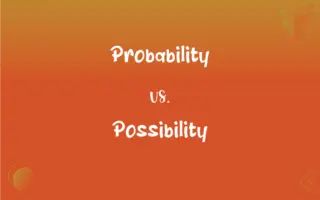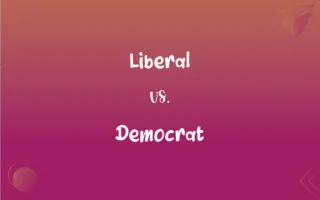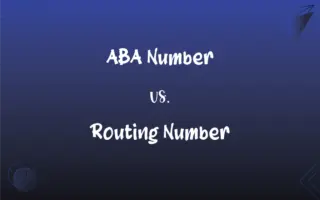Fuzzy Set vs. Crisp Set: What's the Difference?
Edited by Aimie Carlson || By Janet White || Published on February 11, 2024
Fuzzy sets allow degrees of membership, reflecting uncertainty or vagueness, whereas crisp sets have strict, binary membership: an element either belongs or doesn't.

Key Differences
A fuzzy set is a concept in which the boundaries of membership are not sharply defined, allowing elements to have varying degrees of belonging. In contrast, a crisp set has clearly defined boundaries, with each element either belonging entirely or not at all. This difference highlights the flexibility of fuzzy sets in handling ambiguous or gradual scenarios, as opposed to the binary nature of crisp sets.
In fuzzy sets, elements have a membership degree ranging between 0 and 1, representing their level of inclusion in the set. Crisp sets, however, assign a definitive membership status to each element, marked as either 0 (not a member) or 1 (a member). This distinction allows fuzzy sets to model real-world scenarios more accurately where things are not always black or white.
Fuzzy sets are particularly useful in fields like artificial intelligence and decision-making, where ambiguity and gradation are common. Crisp sets are more straightforward and find use in traditional mathematical and logical operations where clear distinctions are necessary.
The concept of a fuzzy set introduces a more nuanced approach to categorization, reflecting the complexity and vagueness found in real-life situations. Crisp sets, with their unambiguous categorization, are simpler but less capable of capturing the subtleties present in many real-world phenomena.
Operations on fuzzy sets, such as union, intersection, and complement, take into account the degree of membership, leading to results that reflect the inherent uncertainty. In contrast, operations on crisp sets follow classic set theory rules, yielding definitive, unambiguous outcomes.
ADVERTISEMENT
Comparison Chart
Membership Definition
Gradual, with degrees between 0 and 1
Binary, either 0 (not a member) or 1 (member)
Boundary Clarity
Vague or blurred boundaries
Clearly defined, sharp boundaries
Suitability
Ideal for uncertain or ambiguous scenarios
Suited for scenarios with clear distinctions
Mathematical Treatment
Uses degrees of truth
Based on classical set theory
Real-world Application
Useful in AI, control systems, and decision-making
Applied in conventional logic and mathematics
ADVERTISEMENT
Fuzzy Set and Crisp Set Definitions
Fuzzy Set
A fuzzy set captures the concept of partial truth, unlike binary true or false.
The fuzzy set of good movies can include films with varying degrees of goodness.
Crisp Set
Crisp sets follow binary logic in membership determination.
In the crisp set of blue cars, a car is either blue (member) or not blue (non-member).
Fuzzy Set
A fuzzy set is a set with unclear boundaries, allowing partial membership.
The set of tall people is fuzzy, as height can vary in degree of tallness.
Crisp Set
Crisp sets are fundamental in classical set theory and mathematics.
The set of even numbers is a crisp set, where each number is definitively even or odd.
Fuzzy Set
In a fuzzy set, each element has a degree of membership ranging from 0 to 1.
In a fuzzy set of warm days, a day with 25°C might have a membership value of 0.7.
Crisp Set
In a crisp set, an element either fully belongs or does not belong at all.
The set of prime numbers is crisp; a number is either prime or not.
Fuzzy Set
In a fuzzy set, the transition from membership to non-membership is gradual.
The fuzzy set of old cars might include cars from different years with varying membership degrees.
Crisp Set
A crisp set is a traditional set with a clear, unambiguous membership.
The set of all integers less than 10 is a crisp set.
Fuzzy Set
Fuzzy sets are used to model concepts that cannot be precisely defined.
The set of healthy foods is fuzzy due to varying nutritional opinions.
Crisp Set
A crisp set is characterized by well-defined boundaries for its elements.
The set of people taller than 6 feet is a crisp set with a clear boundary.
FAQs
Where are fuzzy sets commonly used?
In fields dealing with uncertainty, like AI and control systems.
What is a fuzzy set?
A set where elements have degrees of membership, reflecting gradation and uncertainty.
What is the main advantage of a fuzzy set?
Its ability to handle ambiguous and gradual scenarios.
How is membership defined in a fuzzy set?
Membership in a fuzzy set is defined by a value between 0 and 1.
Are crisp sets suitable for real-world applications?
Yes, but mostly in scenarios with clear-cut distinctions.
Give an example of a crisp set.
The set of all whole numbers between 1 and 5 is a crisp set.
Do fuzzy sets have clear boundaries?
No, fuzzy sets have gradual or blurred boundaries.
What is a crisp set?
A traditional set with strict, binary membership criteria.
What type of membership does a crisp set have?
Membership in a crisp set is either 0 (non-member) or 1 (member).
How do operations in fuzzy sets differ from crisp sets?
Operations in fuzzy sets consider degrees of membership, unlike in crisp sets.
Is mathematical treatment of crisp sets simpler?
Yes, due to their binary and clear-cut nature.
Can crisp sets handle ambiguity?
No, crisp sets are designed for clear, unambiguous categorizations.
Are fuzzy sets more complex than crisp sets?
Yes, due to their non-binary nature and gradation in membership.
Can fuzzy sets provide exact solutions?
Fuzzy sets provide solutions that reflect the uncertainty of the scenario.
What is an example of a fuzzy set in everyday life?
The set of "warm temperatures" can be considered a fuzzy set.
Can crisp sets model gradual changes?
No, crisp sets are not designed to handle gradation.
Can fuzzy sets be converted into crisp sets?
Yes, by defining a threshold to categorize the degrees of membership.
How does ambiguity affect fuzzy sets?
Fuzzy sets embrace ambiguity, allowing for partial membership.
Are crisp sets always exact?
Yes, crisp sets are based on precise definitions and rules.
Are fuzzy sets universally accepted in mathematics?
Fuzzy sets are widely used, but some traditionalists prefer crisp sets for their simplicity.
About Author
Written by
Janet WhiteJanet White has been an esteemed writer and blogger for Difference Wiki. Holding a Master's degree in Science and Medical Journalism from the prestigious Boston University, she has consistently demonstrated her expertise and passion for her field. When she's not immersed in her work, Janet relishes her time exercising, delving into a good book, and cherishing moments with friends and family.
Edited by
Aimie CarlsonAimie Carlson, holding a master's degree in English literature, is a fervent English language enthusiast. She lends her writing talents to Difference Wiki, a prominent website that specializes in comparisons, offering readers insightful analyses that both captivate and inform.































































